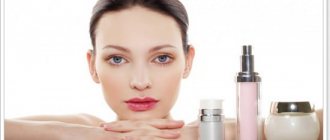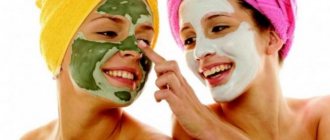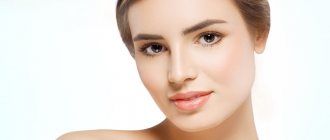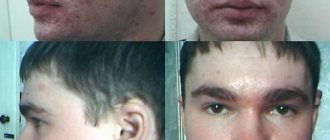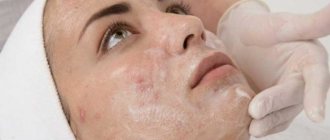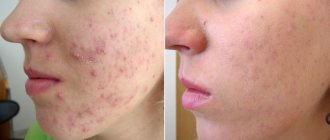Advantages
French cosmetics are popular all over the world, as manufacturers traditionally put quality first. That's why they buy it, even despite the high prices - you can trust it. And we, professionals, know this too.
Algology peeling is no exception. They have their advantages:
- high efficiency;
- well-selected composition;
- natural ingredients;
- minimal contraindications;
- safety to use.
There is also a fairly wide selection of drugs that allows you to effectively work with any skin type and solve a wide variety of problems.
What peelings work against acne
A cosmetic procedure such as peeling is one of the stages in caring for problem skin. But it can really help cope with the problem only if the cause of acne is excessive oily skin, blackheads, clogged pores. As a result of using Anti-acne peeling, the plugs come out, the sebaceous ducts open accordingly, and the inflammatory process does not begin.
This procedure involves removing the top layer of skin. Several methods are used for acne peeling:
- chemical, that is, using various acids;
- mechanical, that is, the top layer is removed with abrasive particles;
- laser.
Laser facial peeling
The first option, depending on the composition, is suitable for relieving inflammation, cleaning the skin and pores, and eliminating acne marks. Acid has a beneficial effect on problematic dermis. They have an anti-inflammatory, antibacterial, absorbable, pore-narrowing and comedolytic effect. For problem skin, anti-acne peeling is performed with the following types of acids:
| Pyrovinogradnaya | It has a powerful antibacterial effect. The acid penetrates into the deep layers of the skin, so it gives a more pronounced anti-aging effect. In addition, it brightens the surface and evens out the relief. Pyruvic acid is used to get rid of acne marks. It does not worsen acne and does not burn during the procedure. However, the acid has a strong odor that irritates the respiratory tract. |
| Almond | It has an anti-inflammatory, antibacterial effect. The acid is used in the form of gel peeling to treat comedones. And during an exacerbation of inflammatory elements, it is included in the water-alcohol composition. |
| Dairy | It is often included in various peeling formulations. |
| Jessner | It consists of salicylic acid, lactic acid and resocin. Peeling helps with acne marks and active inflammatory process. The depth of penetration is determined by the number of layers of application. The first time you can do one or two. Apply it only to inflammation or in combination with mechanical cleaning. The top layer is removed by peeling and comedones are removed, then Jesner is used again. |
| Salicilova | It has strong keratolytic properties. The acid penetrates the pores and sebaceous glands, dissolving plugs. It helps relieve inflammation. But during the procedure a strong burning sensation occurs. In addition, the acid dries the skin, so it is applied locally. |
| Glycolic acid | It belongs to alpha hydroxy acids. It has a very small molecule that penetrates into the deep layers and has a healing effect there. But glycolic acid causes an exacerbation of papulopustular acne. Therefore, after peeling, external antibiotics are used. |
Each works well in certain situations and stages of acne. As a result of periodic use, the skin becomes smoother, more even, lighter and fresher. Inflammatory elements appear less frequently.
Expert opinion
Tatyana Somoilova
Cosmetology expert
It is worth noting that visible results can only be seen after a course of procedures. It is much more effective to use several soft peels than one very strong and traumatic one. It is better to carry out the procedure in the fall, when the sun is not so bright, and there is no risk of hyperpigmentation. If done in the summer, you should apply peeling at night and use sunscreen during the day.
Thus, if inflammation, ulcers, papules are bothering you, then use pyruvic, Jessner, lactic and mandelic acids. To eliminate comedones, “blackheads”, wide pores, non-inflamed acne, salicylic, lactic, pyruvic, almond, and glycolic are used. To even out the skin texture, Jesner, pyruvic and glycolic peels are used.
Product line
A distinctive feature of the line of peelings from Algolodgy is their clear focus on tasks. Therefore, they are divided into types by name, and not by the percentage concentration of biologically active components, like almost all others. Today they are represented by five compositions.
Base
A universal product that is suitable for any skin type. The composition contains 15% lactic acid, 4% glycolic acid and tartaric and malic acids in a 2% concentration. This composition provides a gentle but powerful exfoliating effect and deep cleansing of pores while moisturizing the skin.
Effectively removes the first signs of skin aging, stimulates subcutaneous blood circulation and metabolic processes, refreshes the complexion and slightly tightens enlarged pores.
Can be used as a preparatory step for more severe peelings and can be safely used at home independently (subject to strict adherence to the instructions).
Anti-acne
Designed for oily, problem and combination skin. Successfully fights with:
- enlarged pores;
- acne;
- hyperpigmentation;
- hyperkeratosis;
- acne marks and spots.
Normalizes the activity of the sebaceous glands, evens out skin texture, helps smooth out fine wrinkles.
It contains lactic acid with a concentration of 13.5% and 5% salicylic acid, as well as two patented high-tech complexes - whitening and antiseborrheic.
Essentially, this is a superficial chemical peel with an anti-acne effect from Algologie. Does not dry out the skin, stimulates the natural production of collagen and elastin.
Anti-aging
A much harsher peeling that can quickly rejuvenate the skin and tighten the contours of the face. It contains 35% glycolic acid and 15% citric acid. The product also has a powerful whitening effect, and it successfully copes even with fairly deep pigmentation (of course, not from the first use).
Glycolic acid has a low molecular weight, so it is able to penetrate into the middle and deep layers of the skin.
I categorically do not recommend using this product yourself at home - if handled improperly, it is easy to get serious burns, which may leave scars.
But in experienced hands it is:
- removes signs of photoaging;
- corrects the oval of the face;
- smoothes wrinkles;
- makes scars invisible;
- evens out skin tone;
- removes freckles and age spots.
The action is superficial-medium. The skin after such peeling requires active moisturizing and careful protection from the sun.
For eyes and lips
A unique product, since even many professional lines do not have products for working in these delicate areas. Allows:
- smooth out crow's feet;
- reduce nasolabial folds;
- remove bruises and bags under the eyes;
- slightly tighten your eyelids.
And all this without severe irritation and peeling of the skin!
An ideally selected combination of glycolic and lactic acid (15% and 13.5%, respectively), as well as a substance with a powerful anti-inflammatory effect, argireline, helps to achieve this result.
Enzymatic
The most gentle and delicate product is Algologie peeling with enzymes for sensitive and hypersensitive skin. It contains papaya extract, as well as a patented enzyme complex of four active components. A moisturizing and soothing effect is provided by seaweed extract and plant extracts.
I love watching how this product changes as I work with it. At first it is a gel with delicate granules, then they seem to dissolve and a new oily structure allows you to perform a high-quality facial massage. And upon contact with water, it transforms into a whitish emulsion and is easily removed. Ideal for regular home care.
The best salon peelings for post-acne
In a professional cosmetology salon, you can undergo various types of peelings for scars that appear after an illness.
Carbon
This is a surface cleaning method based on the interaction of carbon dioxide and laser. Scheme:
- a nanogel containing carbon is applied to the skin;
- laser processing is performed;
- dirt, keratinized layer of the epidermis and nanogel residues are brought to the surface by heating.
The advantages of this type of cleansing are the effective cleansing of pores, the absence of painful sensations and pronounced side effects during the recovery period.
The main disadvantages are weak collagen production after peeling, high cost and short duration of the results obtained.
Mesopeeling
A chemical type of peeling for post-acne, in which a cleansing composition is introduced into the epidermis by 1-2 mm, due to which the skin renewal processes are activated from the inside. The active component is acids, which are selected by a specialist taking into account the desired result and the individual characteristics of the skin.
Peeling helps get rid of moderate acne and minimally injures the dermis, so it can be used in the summer.
PRX T33
Peeling for scars, having the following composition:
- trichloroacetic acid – accelerates the regeneration process, activates the production of elastin and collagen, disinfects the skin;
- kojic acid – slows down the formation of melanin and eliminates age spots;
- hydrogen peroxide – accelerates the cleansing process and has a neutralizing effect on trichloroacetic acid.
The complex effect of the above substances helps eliminate defects, even out complexion and normalize the production of subcutaneous sebum. Cleaning is carried out at the middle levels and can be done in the summer.
ABR cleaning
To eliminate post-acne, a composition is selected based on:
- retinol – restores the elasticity of the dermis, stabilizes metabolic processes at the cellular level, effectively fights hyperpigmentation;
- salicylic acid - removes impurities from deep layers and fights the inflammatory process.
The procedure has many disadvantages - pain, severe peeling and swelling, a long rehabilitation period, high cost.
Microdermabrasion
Cleaning is performed using a device using diamond grinding - it removes dead cells, evens out the complexion and accelerates the restoration of the skin.
Application technology
The technology for using each type of peeling is described in detail in the instructions. Training seminars are often organized for cosmetologists, where they talk about nuances that are unnecessary for ordinary people, but important for us. This is why a salon procedure will always be more effective.
Its general step-by-step scheme looks like this:
- thorough make-up removal is performed;
- wash your face with foam or gel;
- then wipe with a degreasing tonic;
- protect the area around the eyes and lips with Vaseline;
- apply the drug to clean, dry skin;
- maintain the time indicated in the instructions;
- neutralized with a special composition;
- rinse thoroughly with running water;
- apply a soothing or moisturizing cream.
Before using any professional product for the first time, and this includes Algologie peeling, you should always do an allergy test, especially if you are working with it at home yourself.
Post-peeling care
Post-peeling care without any special features. Its main tasks are: hydration, regeneration and sun protection. Its solution is ensured by the correct selection and regular use of high-quality creams. After the salon procedure, the cosmetologist gives detailed recommendations. For those who like to experiment at home, I recommend choosing foam with panthenol and gel with aloe vera as universal remedies. They are affordable, effective and do not cause allergies.
In addition, we must not forget about caring for the skin. The following are banned for a few days:
- decorative cosmetics;
- other types of peelings;
- facial massage and masks;
- sauna, swimming pool, solarium;
- playing sports;
- hot baths and showers.
It is also advisable to avoid wind, frost, heat and sudden temperature changes. Before going out into the sun, be sure to apply a UV-blocking cream.
Indications and contraindications for the procedure
Of course, one of the main indications for the use of acne peeling is blackheads and acne vulgaris. But these are far from the only problems that exfoliation can solve. No less often, the procedure is prescribed for the following defects:
- dermatological diseases (solar keratosis, hyperkeratosis, eczema, seborrhea, melasma);
- ingrown hairs after hair removal;
- signs of age (sagging skin, facial wrinkles, senile pigmentation);
- hyperfunction of the sebaceous glands;
- enlarged pores;
- dull complexion;
- post-acne, small scars and cicatrices.
Exfoliation can help get rid of acne on your chest and back. Indications for use are expanded by prescribing superficial peels as preparatory measures for other, more serious cosmetic procedures.
Limitations should also be mentioned here. The list of main contraindications includes:
- individual intolerance to exfoliant components;
- exacerbation of the herpes virus;
- fresh tan;
- psoriasis;
- skin damage in the treatment area;
- neurological diseases (epilepsy);
- malignant neoplasms;
- fever;
- chronic pathologies in the acute stage;
- pregnancy and lactation;
- heart problems, presence of a pacemaker.
The limitations discussed apply to all types of acne peeling. Most exfoliations are recommended to be carried out only in the autumn-winter season, when solar activity is minimal.
Contraindications
Contraindications to chemical peels are standard. There are fewer of them on the surface. But professional products always require increased caution, so they are not used for:
- pregnancy and during breastfeeding;
- liver and kidney failure;
- severe hormonal imbalance;
- active form of the herpes virus;
- exacerbation of chronic diseases;
- dermatitis, eczema and other skin problems;
- abrasions, wounds and cracks in the skin;
- any cancer and autoimmune diseases;
- severely reduced immunity.
Age restrictions are vague. Powerful anti-aging peeling should not be done before 30 and after 55-60 years. And enzyme can be used both in adolescence and in very adulthood. Anti-acne - according to indications, it should not be done on normal healthy skin. The basic one is universal and is used quite widely.
DOES PEELING HELP ACNE?
First, let's figure out what the 3 main types of acne are (which are scientifically called by the general term “blackheads” or “acne”):
- Comedones (blackheads);
- Pustules (pustules-inflammations);
- Papules (“nodules” protruding above the skin).
Indirectly, acne spots (post-acne) can also be included in these categories.
All these imperfections are very unpleasant, and the prospect of peeling off the top layer of horn cells along with all the problems looks very attractive.
This is precisely the meaning of peeling - a procedure that, due to controlled stress on the skin (for example, an acid-based drug), triggers the regeneration process in tissues. As a result, collagen and elastin fibers are naturally renewed, and, depending on the depth of the intervention, different numbers of layers of skin can be exfoliated.
Causes of acne formation
However, you should remember: treating acne with peelings is not always a panacea. Some inflammations occur due to internal disorders in the body (infections, hormonal imbalance, chronic diseases). Such cases may require prior treatment with medications:
- Irregular care: sebaceous plugs appear;
- Increased activity of the sebaceous glands;
- Heredity;
- Long-term exposure to chlorine;
- Taking steroids or halogen-containing (antiseptic) agents;
- Inflammation in areas of ingrown hairs;
- Allergy;
- Infections in wound sites;
- Hormonal changes;
- Intestinal disorders;
- Subcutaneous mite.
In addition, foci of infection can spread to healthy tissue, so fresh rashes must first be treated!
The remaining contraindications are standard: it is forbidden to do peeling with a fresh tan, against the background of a weakened immune system, or if you are allergic to the components of the exfoliant.
Only a specialist can prescribe the correct method in each individual case, because self-diagnosis or unprofessionalism are fraught with post-peeling complications.
Briefly, indications and contraindications for treating acne with peelings can be formulated in the following table:
| IT IS FORBIDDEN | CAN |
|
|
The principle of action here is this: inflammation is caused by bacteria, and their activity can be reduced if you regularly (every month) exfoliate dead horn cells. Deprived of their usual nutrient medium, the bacteria die.
Summing up
Reviews from my clients about these drugs are only positive. If the Algology peeling is chosen correctly for its intended purpose and applied without violating the technology, the results will not take long to arrive. The procedure itself is simple and does not cause much discomfort, since too high concentrations of acids are not used.
Subsequent exfoliation is gentle, without the formation of dense crusts. The skin does not peel off in layers and looks good throughout the recovery period. This is very important for those who work in a busy schedule and cannot afford to sit at home after the procedure.
Perhaps the only significant disadvantage is the rather high price. But, in my opinion, it is justified by the quality.
